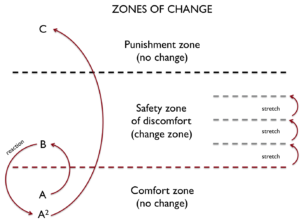”This may sound familiar to you or maybe you have said it yourself recently. It refers to the moment in which you are disappointed in the performance of your people as a leader. You probably had several meetings with your team to explain in a transparent and detailed way the necessity of a change. You did your utmost best to create the burning platform to convince people. You replied patiently to all the questions asked. However, change is lacking and you have the strong feeling that your people will never get it.
Let us assume the change we are talking about is genuinely needed. Let us also assume your explanation was sufficient and clearly understandable. Why is it then that people are not following you? Maybe you have heard from the formula E = Q x A. The Effect of your action (presenting the change needed) = the Quality (of your story) x the Acceptance (by your people). We will not doubt the quality of your story, so the issue has to be the acceptance by your people.
Level of acceptance
In our experience people find their work important and want to contribute. They are also wise enough to understand what you are saying. And it is a myth they do not want to change. Everybody understands change is needed to beat competition in the long run. Blaming them that they don’t get it is counter-productive. It is you that has to be smarter and focus on increasing the acceptance. Among the various factors that influence the level of acceptance are working on safety in the zone of discomfort and building trust by connecting to fears.
Safety zone of discomfort
In the Zones of Change model below you see that your presentation intends to bring people from the comfort zone to the safety zone of discomfort, A > B. After the initial buy-in to the change, the first disappointment in the process creates the reaction to jump back to the old situation B > A2. We are trapped into the comfort zone. When people tend to resist change, they have a small safety zone and a large punishment zone. This means that any amount of change causes them to feel punished. Often we tend to think that pressure by creating fear (burning platform) will force people to jump into the zone of discomfort. Unfortunately, this is not the case; by putting pressure, people skip the safety zone of discomfort and jump immediately into the punishment zone A2 > C.

Change management
Offering clarity and step-by-step supervision creates safety. Individuals experience safety when they dare to take a risk to change behaviour and know they will be supervised and supported in this, not punished or threatened. At the same time creating safety should not be confused with nurturing.
Human emotion
Talking about risk, when did you take the last risk in your personal work environment? Hopefully not too long ago, because that means you are willing to learn and develop yourself. Most likely you were able to take that risk because you felt the trust to do it. Asking your people to change their behaviour is the same as asking them to take a risk. The fear of taking risks is a natural human emotion, because it saves us from all kinds of frightening situations.
Really connect
As a leader you have to build a trustworthy environment in which it becomes natural that people take risks, because it is the only way to start a change. The best way to do this is to really connect, preferably on a one-on-one basis, on the shop floor. In case you don’t know what to do anymore, walk around and ask people questions like ‘What is your biggest fear after listening to my presentation?’ or ‘What is needed to have you taking the first (experimental) step into the direction needed?’ You will see that people will start feeling that you actually care about them and you want to support them in crossing that difficult line into the safety zone of discomfort.
If you are still not convinced, ask yourself a question: do you like to stand on a burning platform?


